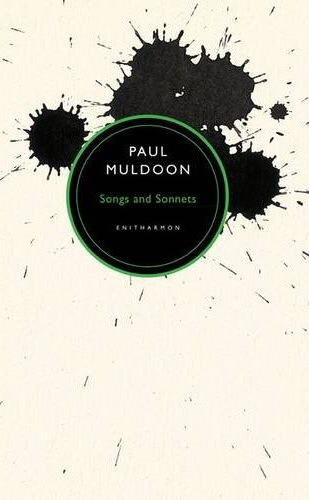For a collection half-focused on sonnets, you might be forgiven for expecting more from the capable, albeit sometimes overrated, Paul Muldoon. Never do the fourteen-liners reach the dizzying heights of Michael Donaghy’s ‘The Present’ or Don Paterson’s ‘Waking with Russell’, but that isn’t to say that they fail, just that they underachieve. When a poet devotes time to a specific form you expect him to become a master of that form, but there aren’t many signs of that in Songs and Sonnets. And there aren’t enough poems here to compensate for the lack of magic. In the setting of a cowshed, ‘A Dent’ comes closest to this level of ingenuity. Muldoon passes the first test, originality, which, to be fair, is always difficult in a setting which has been covered to death. Although Muldoon resurrects successfully, and stunningly in some stanzas, this poem, the pick of the sonnets, has its limits. Still, the highlights are magnificent:
The height of one stall at odds with the next in your grandfather’s byre
where cattle allowed themselves to speak only at Yule
gave but little sense of why you taught us to admire
the capacity of a three-legged stool
to take pretty much everything in its stride,

by Paul Muldoon
48pp, Enitharmon, £9.99
Certain lines from ‘A Dent’ might have fitted in nicely to Paul Farley’s comedic ‘The Milk Nostalgic Industries’, but the sombre tone of a hard done-by working man lies beneath the layers of humour. The poem never connects one person to another, the way ‘The Present’ and ‘Waking with Russell’ both manage to, but it does give the reader a connection to two people, plus a third if you count the narrator, although you may feel he is too symbolic to count. The skipping of a generation lends the poem a mournful, rueful tone that you will want to put right, as does the final two lines.
The depth of a dent in the flank of your grandfather’s cow
from his having leaned his brow
against it morning and night
for twenty years of milking by hand
gave but little sense of how distant is the land
on which you had us set our sights.
Humour in other poems arrives in the form of a bomber and characters of Charles Dickens, in ‘Pip and Magwitch’, and bandits, two-to-a-horse, in ‘Shoot ‘Em Up’, but is humour enough to save the poems which are already in short supply? The rhyming is consistently original and smooth to the ear and only falters on the odd occasion. In ‘Honey’, what looks odd on the page (‘and fills in the great gash’, the sixth line, rhymes with the first ‘Our plane takes hill upon hill long since cleared of pines. The flash’) still comes up trumps for the ear, with Paul Muldoon’s manipulation of punctuality and sentence lengths working a treat.
The less than subtle wordplay in poems such as ‘Le Flanneur’ (Now the girl on whom you used to dote/is in her dotage./The Evening Herald is less than Heraldic.) is a mainstay in the lyrics, the songs of the first half of the book’s title. In ‘Resistance’, a list of famous suckers for love, Isolde and Marian both surrender to desire:
A leader in her field
A Cold War strategist
Isolde would yield
To Tristan’s tryst.
Then, later:
Once just good friends
In the green wood
Marian would bend
For Robin Hood
There is more rude humour in ‘If Any of This Gets Out’ and ‘Party Lines’, though the rudeness is only slight, which is a shame because Muldoon writes crude humour very well. ‘Mad for You’ is typical of the lyrics in the book, not for its momentary similarities to Glyn Maxwell’s ‘Deep Sorriness Atonement Song’ in terms of content (slightly) and rhythm (more so), but its list-technique, shared by many of the songs and even some of the sonnets, though the latter form is treated with more subtlety in the list-technique’s case.
Overall, Songs and Sonnets is a must for any die-hard Muldoon fan, anyone intrigued by the link between lyrics and poems, or anyone who can appreciate a whole book merely for one or two great poems and is willing to spend good money on it.










